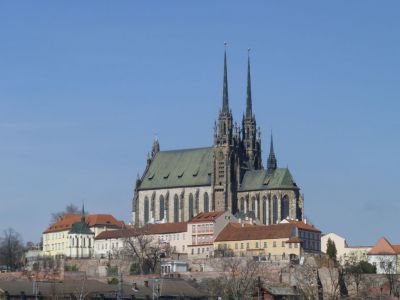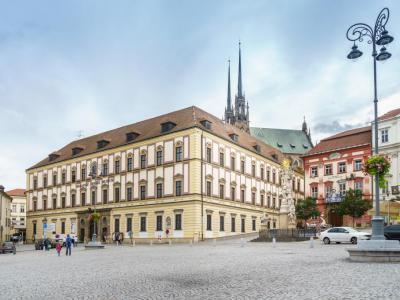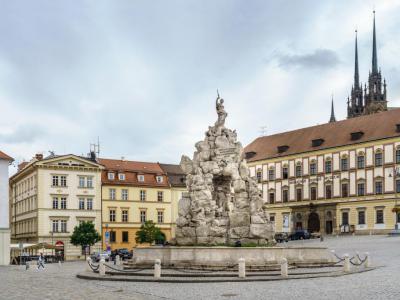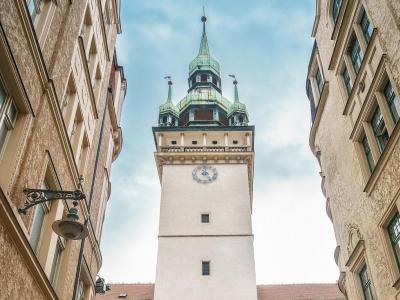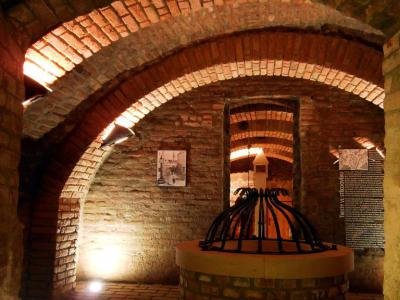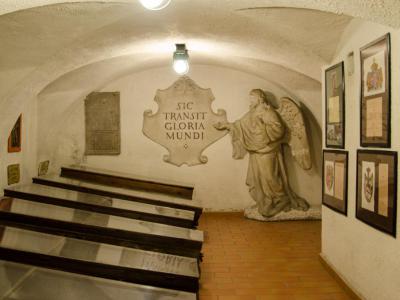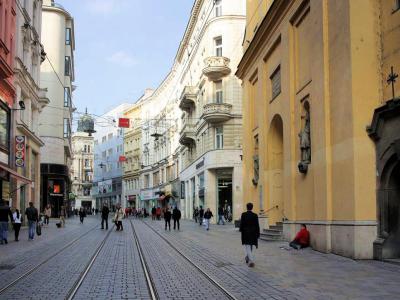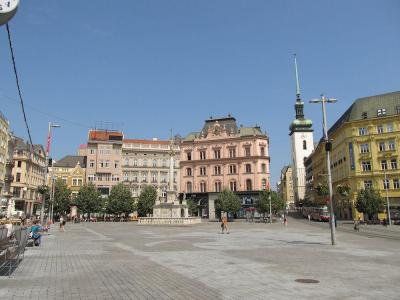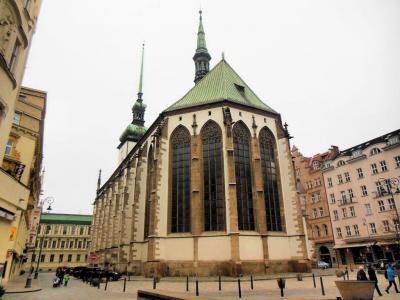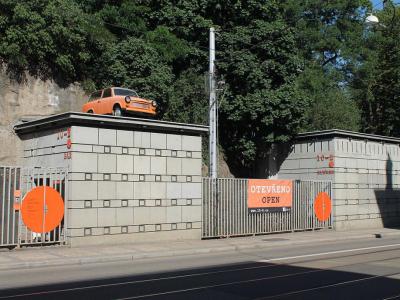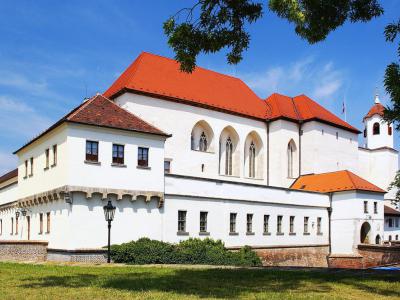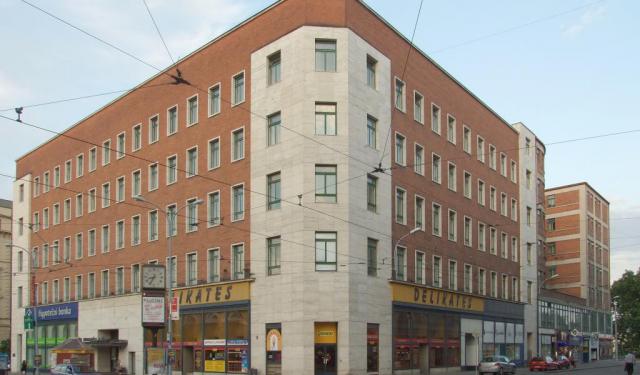Brno Introduction Walking Tour (Self Guided), Brno
Brno is the second-largest city in the Czech Republic. Located in the South Moravian Region, it is the center of Czech's judiciary and the former capital of Moravia.
Brno is known for its exhibition center, one of the largest in Europe. It is also known for its international fireworks competition, Fire of Brno. The long history of fireworks and pyrotechnics are seen in the Spilberk Castle museum.
The first settlement in the area was Old Castle, which was in place from the Neolithic Age through the 11th century. Brno was established in 1091. It was recognized as a royal city in 1243.
Attempts to take over the city were carried out many times over the centuries, including sieges on Brno carried out by the Swedes and the Hussites. They were all unsuccessful.
German occupation took over Czech lands during World War II. The Gestapo held their headquarters at the Masaryk University Faculty of Law and turned the residence halls into prisons. A detainment camp for Auschwitz was located in Brno with mostly Polish and Romani people. Roughly 10,000 Jews were taken from Brno to Auschwitz.
At the end of the war, when Czechoslovakia was made independent, Moravia was no longer independent, and Brno ceased being the capital. A new focus was placed on the industry. Once the communist rule was no longer in place, Brno flourished in culture and technology.
Visitors to Brno will find a great deal of history and art while touring the city. The Moravian Museum displays the culture of the region, while the Brno Ossuary is a must-see location that contains the bones of over 50,000 residents.
The medieval Spilberk Castle and the Cathedral of St. Peter and Paul are two of the most important buildings in the city. They are often viewed as symbols of Brno. Both are open to the public. Likewise, Villa Tugendhat is a much-visited building due to its amazing feats in modern architecture. Built in the early 20th century, Villa Tugendhat was constructed with modern air conditioning and retracting glass walls.
Take this self-guided walking tour to see these and many other impressive places in Brno, Czech Republic.
Brno is known for its exhibition center, one of the largest in Europe. It is also known for its international fireworks competition, Fire of Brno. The long history of fireworks and pyrotechnics are seen in the Spilberk Castle museum.
The first settlement in the area was Old Castle, which was in place from the Neolithic Age through the 11th century. Brno was established in 1091. It was recognized as a royal city in 1243.
Attempts to take over the city were carried out many times over the centuries, including sieges on Brno carried out by the Swedes and the Hussites. They were all unsuccessful.
German occupation took over Czech lands during World War II. The Gestapo held their headquarters at the Masaryk University Faculty of Law and turned the residence halls into prisons. A detainment camp for Auschwitz was located in Brno with mostly Polish and Romani people. Roughly 10,000 Jews were taken from Brno to Auschwitz.
At the end of the war, when Czechoslovakia was made independent, Moravia was no longer independent, and Brno ceased being the capital. A new focus was placed on the industry. Once the communist rule was no longer in place, Brno flourished in culture and technology.
Visitors to Brno will find a great deal of history and art while touring the city. The Moravian Museum displays the culture of the region, while the Brno Ossuary is a must-see location that contains the bones of over 50,000 residents.
The medieval Spilberk Castle and the Cathedral of St. Peter and Paul are two of the most important buildings in the city. They are often viewed as symbols of Brno. Both are open to the public. Likewise, Villa Tugendhat is a much-visited building due to its amazing feats in modern architecture. Built in the early 20th century, Villa Tugendhat was constructed with modern air conditioning and retracting glass walls.
Take this self-guided walking tour to see these and many other impressive places in Brno, Czech Republic.
How it works: Download the app "GPSmyCity: Walks in 1K+ Cities" from Apple App Store or Google Play Store to your mobile phone or tablet. The app turns your mobile device into a personal tour guide and its built-in GPS navigation functions guide you from one tour stop to next. The app works offline, so no data plan is needed when traveling abroad.
Brno Introduction Walking Tour Map
Guide Name: Brno Introduction Walking Tour
Guide Location: Czech Republic » Brno (See other walking tours in Brno)
Guide Type: Self-guided Walking Tour (Sightseeing)
# of Attractions: 11
Tour Duration: 2 Hour(s)
Travel Distance: 2.7 Km or 1.7 Miles
Author: NatalyS
Sight(s) Featured in This Guide:
Guide Location: Czech Republic » Brno (See other walking tours in Brno)
Guide Type: Self-guided Walking Tour (Sightseeing)
# of Attractions: 11
Tour Duration: 2 Hour(s)
Travel Distance: 2.7 Km or 1.7 Miles
Author: NatalyS
Sight(s) Featured in This Guide:
- Katedrála Sv. Petra a Pavla (Cathedral of St. Peter and Paul)
- Moravské Zemské Muzeum (Moravian Museum)
- Zelný Trh (Vegetable Market Square) and Parnas Fountain
- The Old Town Hall
- Labyrinth under Vegetable Market
- Capuchin Monastery and Vault
- Masarykova Street
- Náměstí Svobody (Liberty Square)
- St. James' Church and Brno Ossuary
- 10-Z Bunker Brno
- Špilberk Castle
1) Katedrála Sv. Petra a Pavla (Cathedral of St. Peter and Paul) (must see)
The Cathedral of Saint Peter and Paul is a Roman Catholic cathedral and parish church located on Petrov hill in Brno. It is more commonly referred to as "Petrov" by locals. The cathedral that stands today was built in the late 17th century with many additions and renovations undergone over the years.
Some historical records show churches on the site of Petrov since the 12th century. The first was a Romanesque chapel built in 1140. The next was a Romanesque and Gothic church dedicated to Saint Peter in 1230. A new religious edifice dedicated to Saint Peter and Saint Paul was erected in the 15th century. It burned in 1643 during the Thirty Years War.
The exterior of the Cathedral of Saint Peter and Paul was designed in the Gothic Revival style by architect Frantisek Benedikt Klicnik. The towers, standing at more than 275 feet, were added in 1909. They were designed by architect August Kirstein.
The interior was designed by architect Moric Grimm in the late 18th century. Most of the Baroque features remain in place today. Gothic work on the interior was added by architects August Prokop and K. Woresch in the late 19th century. They added a chapel and presbytery, a high altar with carved scenes of the twelve apostles, and the crucifixion designed by Viennese sculptor Josef Leimer.
The cathedral bells ring at 11 AM rather than noon as a nod to the Thirty Years' War. During that war, the Swedes stated they would end the attack if they had not taken the city by midday on August 15. The church bells rang an hour early to put an end to the siege. They have continued to ring early since then.
Some historical records show churches on the site of Petrov since the 12th century. The first was a Romanesque chapel built in 1140. The next was a Romanesque and Gothic church dedicated to Saint Peter in 1230. A new religious edifice dedicated to Saint Peter and Saint Paul was erected in the 15th century. It burned in 1643 during the Thirty Years War.
The exterior of the Cathedral of Saint Peter and Paul was designed in the Gothic Revival style by architect Frantisek Benedikt Klicnik. The towers, standing at more than 275 feet, were added in 1909. They were designed by architect August Kirstein.
The interior was designed by architect Moric Grimm in the late 18th century. Most of the Baroque features remain in place today. Gothic work on the interior was added by architects August Prokop and K. Woresch in the late 19th century. They added a chapel and presbytery, a high altar with carved scenes of the twelve apostles, and the crucifixion designed by Viennese sculptor Josef Leimer.
The cathedral bells ring at 11 AM rather than noon as a nod to the Thirty Years' War. During that war, the Swedes stated they would end the attack if they had not taken the city by midday on August 15. The church bells rang an hour early to put an end to the siege. They have continued to ring early since then.
2) Moravské Zemské Muzeum (Moravian Museum)
The Moravian Museum is a scientific and cultural museum within the Dietrichstein Palace. It is the second-largest and second-oldest museum in the Czech Republic. Currently, the museum is funded by the Ministry of Culture and is a member of the Czech Association of Museums and Galleries.
Dietrichstein Palace was built in 1616 as a home for Cardinal Franz von Dietrichstein. The Baroque-style building is one of the largest in the city. It was turned into the Moravian Museum by Emperor Francis II in 1817 and was established with the help of renowned natural scientist Christian Carl Andre and Supreme Czech Chancellor Antonin Bedrich Mitrovsky.
Exhibits in the Moravian Museum show the history of Moravia, minerals found within the land, cultural changes throughout the years, and artifacts from prehistory. Its collections contain over six million objects from the natural and social sciences.
While the central location of the Moravian Museum is in Dietrichstein Palace, there are several other exhibition places throughout the city. Some of these are the Palace of Noble Ladies, the Anthropos Pavilion, and the Mendel Museum. There are also homes, castles and monuments owned and managed by the museum.
Dietrichstein Palace was built in 1616 as a home for Cardinal Franz von Dietrichstein. The Baroque-style building is one of the largest in the city. It was turned into the Moravian Museum by Emperor Francis II in 1817 and was established with the help of renowned natural scientist Christian Carl Andre and Supreme Czech Chancellor Antonin Bedrich Mitrovsky.
Exhibits in the Moravian Museum show the history of Moravia, minerals found within the land, cultural changes throughout the years, and artifacts from prehistory. Its collections contain over six million objects from the natural and social sciences.
While the central location of the Moravian Museum is in Dietrichstein Palace, there are several other exhibition places throughout the city. Some of these are the Palace of Noble Ladies, the Anthropos Pavilion, and the Mendel Museum. There are also homes, castles and monuments owned and managed by the museum.
3) Zelný Trh (Vegetable Market Square) and Parnas Fountain
Vegetable Market Square is a traditional marketplace in the historical center of Brno. It first opened in 1190, before Brno was established. It was a general market before it focused on fruits and vegetables. The market has been in continuous use since its opening.
Vegetable Market Square offers shops selling vegetables, fruit, flowers, baked goods, cheese, spices, and other food items. There are also several restaurants and food carts in the square.
Along with shopping, many landmarks are located in and around Vegetable Market Square. Visitors will find easy access to Dietrichstein Palace and the Moravian Museum. They will also see the Reduta Theatre, the oldest theatre building in Central Europe. Tourists enjoy the Labyrinth under the Vegetable Market, a unique system of underground passages and cellars from the Middle Ages.
The Vegetable Market Square houses a monumental Parnas Fountain. The Baroque-style fountain was placed in the square in 1695. It was designed by Austrian architect Johann Bernhard Fischer von Erlach and built by Austrian sculptor Adam Tobias Kracker.
The basin of the fountain supports a six-pointed layout which serves as a base for imitation rocks with caves. There are mythical figures, including Heracles leading the three-headed dog Cerberus on a chain. The work is one of the most valuable monuments of Baroque sculpture in Brno.
Vegetable Market Square offers shops selling vegetables, fruit, flowers, baked goods, cheese, spices, and other food items. There are also several restaurants and food carts in the square.
Along with shopping, many landmarks are located in and around Vegetable Market Square. Visitors will find easy access to Dietrichstein Palace and the Moravian Museum. They will also see the Reduta Theatre, the oldest theatre building in Central Europe. Tourists enjoy the Labyrinth under the Vegetable Market, a unique system of underground passages and cellars from the Middle Ages.
The Vegetable Market Square houses a monumental Parnas Fountain. The Baroque-style fountain was placed in the square in 1695. It was designed by Austrian architect Johann Bernhard Fischer von Erlach and built by Austrian sculptor Adam Tobias Kracker.
The basin of the fountain supports a six-pointed layout which serves as a base for imitation rocks with caves. There are mythical figures, including Heracles leading the three-headed dog Cerberus on a chain. The work is one of the most valuable monuments of Baroque sculpture in Brno.
4) The Old Town Hall (must see)
The Old Town Hall is a building in Brno's historical center. While it previously served as a home for public meetings, it is now a cultural center. The Old Town Hall has an art gallery, history exhibit, and information center.
The building is the oldest secular edifice in Brno that is still standing. The original structure, built in 1240, was greatly expanded during the 15th century, with new additions steadily constructed from 1577 through 1905. It ceased its use as a town hall in 1935. Most of the construction and details use the Gothic architecture style by Austrian architect and sculptor Anton Pilgram.
The Old Town Hall's courtyard is a venue for concerts, open-air theatres, film screenings, and festivals. The courtyard uses Renaissance arcades with early Baroque touches.
The Old Town Hall is open year-round. However, only those tourists who visit Brno from June through September may climb the 206-foot tower to see a stunning view of the city.
The building is the oldest secular edifice in Brno that is still standing. The original structure, built in 1240, was greatly expanded during the 15th century, with new additions steadily constructed from 1577 through 1905. It ceased its use as a town hall in 1935. Most of the construction and details use the Gothic architecture style by Austrian architect and sculptor Anton Pilgram.
The Old Town Hall's courtyard is a venue for concerts, open-air theatres, film screenings, and festivals. The courtyard uses Renaissance arcades with early Baroque touches.
The Old Town Hall is open year-round. However, only those tourists who visit Brno from June through September may climb the 206-foot tower to see a stunning view of the city.
5) Labyrinth under Vegetable Market
The Labyrinth under the Vegetable Market is a series of underground passages beneath the Vegetable Market Square in Brno. It consists of corridors and cellars that date as far back as the Middle Ages.
Initially, the Labyrinth was used for the grocers who sold their wares at the Vegetable Market. The chilly atmosphere was ideal for keeping fruit and vegetables fresh. The Labyrinth was also utilized for brewing beer and aging wine. During wartime, the cellars served as a shelter from heavy artillery.
The passages were not all connected until 2009 when they underwent reconstruction. They opened to the public in 2011. Tourists should note that there are 221 steps required to reach the Labyrinth from the street level. Once they arrive, they will see displays that show old taverns, archaeological findings, and replicas of the pillory and stockades that once sat in the Vegetable Market Square.
Initially, the Labyrinth was used for the grocers who sold their wares at the Vegetable Market. The chilly atmosphere was ideal for keeping fruit and vegetables fresh. The Labyrinth was also utilized for brewing beer and aging wine. During wartime, the cellars served as a shelter from heavy artillery.
The passages were not all connected until 2009 when they underwent reconstruction. They opened to the public in 2011. Tourists should note that there are 221 steps required to reach the Labyrinth from the street level. Once they arrive, they will see displays that show old taverns, archaeological findings, and replicas of the pillory and stockades that once sat in the Vegetable Market Square.
6) Capuchin Monastery and Vault
The Capuchin Vault is a crypt in the basement of the Capuchin Monastery, founded in the mid-17th century. It is a funeral room mainly for Capuchin friars.
The Capuchins viewed coffins as a luxury not afforded to them due to their vow of poverty. Therefore, the bodies were simply placed in the crypt. Due to the conditions of the basement, the bodies were mummified. They are used in scientific studies and may be viewed by tourists.
One of the bodies in the Capuchin Crypt is that of Saint Clementaine. She was a Roman noblewoman. Her remains and some of her relics rest near the entrance.
Reaching the crypt requires navigating narrow passageways that also offer views of the bodies of dignitaries. One notable corpse shows a body frozen in fear with a note, showing that she was accidentally buried alive. Above the crypt is an etched warning written in Czech. It states, "As you are now, we once were; as we are now, you shall be."
The Capuchins viewed coffins as a luxury not afforded to them due to their vow of poverty. Therefore, the bodies were simply placed in the crypt. Due to the conditions of the basement, the bodies were mummified. They are used in scientific studies and may be viewed by tourists.
One of the bodies in the Capuchin Crypt is that of Saint Clementaine. She was a Roman noblewoman. Her remains and some of her relics rest near the entrance.
Reaching the crypt requires navigating narrow passageways that also offer views of the bodies of dignitaries. One notable corpse shows a body frozen in fear with a note, showing that she was accidentally buried alive. Above the crypt is an etched warning written in Czech. It states, "As you are now, we once were; as we are now, you shall be."
7) Masarykova Street
Masarykova Street is a popular shopping area in Brno. Tourists will find shops that sell food, souvenirs, and clothing. They will also encounter a variety of bars and restaurants.
The street was officially named Masarykova Street in 1930, but its history dates hundreds of years before that. It was used as a major trade route since the 12th century. Construction on the street began in 1850 and was completed in 1864.
Masarykova Street, formerly Ferdinand Street, was renamed following the fall of the monarchy. Its current name is in honor of Tomas Garrigue Masaryk, the first president of the Czechoslovak Republic.
Many buildings along Masarykova Street hold interest to lovers of architecture. Architects like Viktor Kovacic, Leopold Bauer, Otto Eisler, and Rudolf Lubinsky designed residential palaces and functional buildings during the late 19th and early 20th centuries.
Masarykova Street connects Liberty Square with the train station.
The street was officially named Masarykova Street in 1930, but its history dates hundreds of years before that. It was used as a major trade route since the 12th century. Construction on the street began in 1850 and was completed in 1864.
Masarykova Street, formerly Ferdinand Street, was renamed following the fall of the monarchy. Its current name is in honor of Tomas Garrigue Masaryk, the first president of the Czechoslovak Republic.
Many buildings along Masarykova Street hold interest to lovers of architecture. Architects like Viktor Kovacic, Leopold Bauer, Otto Eisler, and Rudolf Lubinsky designed residential palaces and functional buildings during the late 19th and early 20th centuries.
Masarykova Street connects Liberty Square with the train station.
8) Náměstí Svobody (Liberty Square) (must see)
Liberty Square (Náměstí Svobody) is the vibrant heart of Brno. Unlike typical historical city centers, Liberty Square has a unique character that blends the old with the new, creating an atmosphere that is both dynamic and steeped in history.
The square's unusual triangular shape was defined by ancient trade routes and a stream that once served as the city's sewer in the 13th century. This area, historically known as Lower Market (Dolní trh) and later Big Square (Velké náměstí), has been a central part of Brno since it was first mentioned in records from the 13th century.
One of the most striking features of Liberty Square is the black granite astronomical clock, which has become a symbol of the city. This clock, resembling a spaceship, only shows the time 11:00 AM, a nod to Brno's legendary history. It commemorates the successful defense of the city during the Swedish siege in 1645. Every day at this time, a small glass of marble drops from the clock, offering a unique souvenir for those quick enough to catch it.
The square is also home to several historically and architecturally significant buildings. The House of the Lords of Lipá, a Renaissance-style building, is adorned with etched mythological and biblical scenes. Klein Palace, a Renaissance Revival structure, reflects the industrial legacy of the Klein family, known for their ironworks. The House of Four Giants, designed in 1902, features four imposing figures supporting the building's facade.
In addition to its architectural landmarks, Liberty Square is adorned with several sculptures and monuments. The early Baroque plague column from 1689 serves as a poignant reminder of past plague outbreaks in the city. Two bronze fountains, featuring poetic inscriptions by local poet Jan Skácel, add to the square's artistic charm.
Throughout the year, Liberty Square hosts numerous cultural events, including Easter markets, wine festivals celebrating the opening of Saint Martin’s wines, and the festive Brno Christmas market. These events bring the square to life, making it not just a historical site but a lively gathering place for both locals and visitors.
The square's unusual triangular shape was defined by ancient trade routes and a stream that once served as the city's sewer in the 13th century. This area, historically known as Lower Market (Dolní trh) and later Big Square (Velké náměstí), has been a central part of Brno since it was first mentioned in records from the 13th century.
One of the most striking features of Liberty Square is the black granite astronomical clock, which has become a symbol of the city. This clock, resembling a spaceship, only shows the time 11:00 AM, a nod to Brno's legendary history. It commemorates the successful defense of the city during the Swedish siege in 1645. Every day at this time, a small glass of marble drops from the clock, offering a unique souvenir for those quick enough to catch it.
The square is also home to several historically and architecturally significant buildings. The House of the Lords of Lipá, a Renaissance-style building, is adorned with etched mythological and biblical scenes. Klein Palace, a Renaissance Revival structure, reflects the industrial legacy of the Klein family, known for their ironworks. The House of Four Giants, designed in 1902, features four imposing figures supporting the building's facade.
In addition to its architectural landmarks, Liberty Square is adorned with several sculptures and monuments. The early Baroque plague column from 1689 serves as a poignant reminder of past plague outbreaks in the city. Two bronze fountains, featuring poetic inscriptions by local poet Jan Skácel, add to the square's artistic charm.
Throughout the year, Liberty Square hosts numerous cultural events, including Easter markets, wine festivals celebrating the opening of Saint Martin’s wines, and the festive Brno Christmas market. These events bring the square to life, making it not just a historical site but a lively gathering place for both locals and visitors.
9) St. James' Church and Brno Ossuary (must see)
The Church of St. James the Greater is a stunning Late Gothic, three-aisled church adorned with Baroque details. Its origins date back to the early 13th century. Inside, you'll find the grave of Marshal Louis Raduit de Souches, the renowned defender of Brno during the Thirty Years' War, alongside a rare ossuary.
The church has recently undergone renovations, and its brilliance has been fully restored. It features now a brand-new guided tour through its monumental four-story roof structure. Visitors can also enjoy a modern audio-visual light show that delves into the history of Brno and the St. James' Church.
The Brno Ossuary is an underground vault under the Church of Saint James. It is the second-largest ossuary in Europe. The number of people buried here is estimated to exceed 50,000.
The ossuary was founded in the 17th century. The purpose of the space was to find a final resting place for bones while freeing up space in the overly crowded cemetery at the Church of Saint James. It became customary to re-open graves about ten years after burial and have the remains moved into the ossuary.
The reforms introduced by Roman Emperor Joseph II in 1784 resulted in churchyards being closed down for hygienic reasons. The remains from the graves were placed in crypts instead. The headstones at the Saint James Cemetery were removed and used to pave the ground. The ossuary was gradually forgotten.
It was rediscovered in 2001. Brno Ossuary opened to the public in 2012.
The church has recently undergone renovations, and its brilliance has been fully restored. It features now a brand-new guided tour through its monumental four-story roof structure. Visitors can also enjoy a modern audio-visual light show that delves into the history of Brno and the St. James' Church.
The Brno Ossuary is an underground vault under the Church of Saint James. It is the second-largest ossuary in Europe. The number of people buried here is estimated to exceed 50,000.
The ossuary was founded in the 17th century. The purpose of the space was to find a final resting place for bones while freeing up space in the overly crowded cemetery at the Church of Saint James. It became customary to re-open graves about ten years after burial and have the remains moved into the ossuary.
The reforms introduced by Roman Emperor Joseph II in 1784 resulted in churchyards being closed down for hygienic reasons. The remains from the graves were placed in crypts instead. The headstones at the Saint James Cemetery were removed and used to pave the ground. The ossuary was gradually forgotten.
It was rediscovered in 2001. Brno Ossuary opened to the public in 2012.
10) 10-Z Bunker Brno
10-Z Bunker Brno was an air-raid shelter built during World War II. It was used for citizens who needed a safe space to stay away from targets from the United States and the Soviet Union.
After World War II ended, 10-Z Bunker Brno found a new purpose. It served as a wholesale wine store that sold wine to restaurants and clubs. It was then confiscated by the Communist regime in 1948 and repurposed into a nuclear shelter that could hold up to 500 people.
10-Z Bunker Brno opened to the public as a tourist attraction in 2016. Visitors can take a guided or unguided tour where they will see videos about the technical aspects of the shelter and the people connected to this place.
Night tours are available for those who prefer a more eerie environment. Among the exhibits, visitors will see the doors to the death cells from the former Brno prison. Many are inscribed with messages left by those who were awaiting execution.
After World War II ended, 10-Z Bunker Brno found a new purpose. It served as a wholesale wine store that sold wine to restaurants and clubs. It was then confiscated by the Communist regime in 1948 and repurposed into a nuclear shelter that could hold up to 500 people.
10-Z Bunker Brno opened to the public as a tourist attraction in 2016. Visitors can take a guided or unguided tour where they will see videos about the technical aspects of the shelter and the people connected to this place.
Night tours are available for those who prefer a more eerie environment. Among the exhibits, visitors will see the doors to the death cells from the former Brno prison. Many are inscribed with messages left by those who were awaiting execution.
11) Špilberk Castle (must see)
Spilberk Castle is a castle and citadel from the 13th century. Its construction began under the Premyslid kings, a Bohemian royal dynasty, and was completed by King Ottokar II of Bohemia.
The royal castle was eventually used as a fortification and later became a prison. Spilberk Castle was known as the harshest prison in all of the Austrian Empire. It was first used to imprison Protestants, then became the place for revolutionaries and other political prisoners.
The prison was dissolved in 1855 by Emperor Franz Joseph I. Once the prisoners had all been moved out, it was converted into barracks. However, it served again as a prison during World War II. Civilian objectors and prisoners of war were held in the castle until they were either put to death or sent to Nazi concentration camps.
Spilberk Castle left its dark history behind in 1959 when it became the seat of the Brno City Museum. A permanent exhibit shows the castle's history from its time as a fortress to its tenure as a prison. The history of Brno is also on display. Other permanent exhibits include medicinal research of the region, architecture, and a showcase on fireworks and pyrotechnics.
The castle has a restored lapidarium where stone monuments are displayed. The lapidarium is only available via guided tours. Visitors will also enjoy the Lookout Tower. This tower is the highest spot in Brno that offers a 360-degree view of the city. Visitors should note that the spiral staircase has more than 100 steps to reach the top.
The royal castle was eventually used as a fortification and later became a prison. Spilberk Castle was known as the harshest prison in all of the Austrian Empire. It was first used to imprison Protestants, then became the place for revolutionaries and other political prisoners.
The prison was dissolved in 1855 by Emperor Franz Joseph I. Once the prisoners had all been moved out, it was converted into barracks. However, it served again as a prison during World War II. Civilian objectors and prisoners of war were held in the castle until they were either put to death or sent to Nazi concentration camps.
Spilberk Castle left its dark history behind in 1959 when it became the seat of the Brno City Museum. A permanent exhibit shows the castle's history from its time as a fortress to its tenure as a prison. The history of Brno is also on display. Other permanent exhibits include medicinal research of the region, architecture, and a showcase on fireworks and pyrotechnics.
The castle has a restored lapidarium where stone monuments are displayed. The lapidarium is only available via guided tours. Visitors will also enjoy the Lookout Tower. This tower is the highest spot in Brno that offers a 360-degree view of the city. Visitors should note that the spiral staircase has more than 100 steps to reach the top.
Walking Tours in Brno, Czech Republic
Create Your Own Walk in Brno
Creating your own self-guided walk in Brno is easy and fun. Choose the city attractions that you want to see and a walk route map will be created just for you. You can even set your hotel as the start point of the walk.
Functionalist Architecture in Brno
Functionalist architecture, a style that sought to meet the needs of the rapidly evolving industrial society, emerged in Europe in the wake of World War I.
After Czechoslovakia gained independence in 1918, Brno, the second-largest city in the country, developed rapidly both economically and politically. Its architecture reflected a modernist approach that prioritized functionality and... view more
Tour Duration: 1 Hour(s)
Travel Distance: 1.5 Km or 0.9 Miles
After Czechoslovakia gained independence in 1918, Brno, the second-largest city in the country, developed rapidly both economically and politically. Its architecture reflected a modernist approach that prioritized functionality and... view more
Tour Duration: 1 Hour(s)
Travel Distance: 1.5 Km or 0.9 Miles
The Most Popular Cities
/ view all



